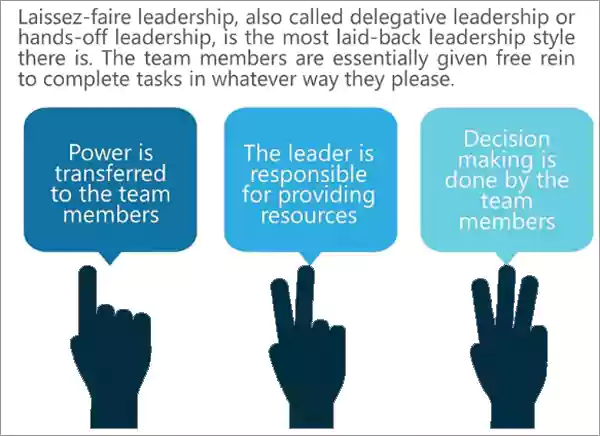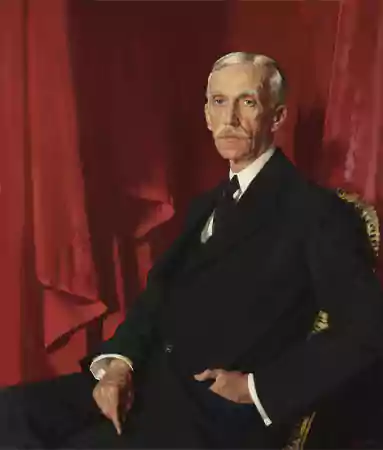
Have you heard the term “Laissez Faire leadership” in your professional circles? Not sure what that means?
“Laissez-faire” is a French word that means “letting people do as they choose.” Laissez Faire Leadership is opposite of micromanaging. This style of leadership allows their followers to have the authority to make their own decisions and manage their desks without the need to receive explicit instruction.

The Laissez Faire leadership style involves letting group members make choices and putting leaders in a supporting role. It is also referred to as “Delegative leadership.” Let’s begin by unraveling the layers of this leadership style.
What is Laissez Faire Leadership?
Delegative leadership is a management style that emphasizes everyone’s participation. It is also referred to as a “Participative group.” Under this approach, managers have complete faith and confidence in their employees in all areas; they constantly solicit and use suggestions and opinions from their employees.
Furthermore, managers or leaders offer financial incentives for teamwork and participation in tasks such as goal-setting and evaluating progress toward objectives.
Leaders foster group decision-making throughout the company, communicate frequently with colleagues and higher-ups, and work together as a unit with their subordinates.
In layman’s terms, Laissez faire leadership means allowing people to do their work as they see fit, without receiving orders from superiors, with their own free will, and most importantly, at their own pace.
Characteristics of Laissez Faire Leadership

Laissez faire leadership style has some distinguishing characteristics. Let’s have a glance at them by going through the pointers mentioned below.
- It is a hands-off kind of approach.
- The leader has to solve all the problems by their own self, though they are free to consult others.
- Laissez-faire leader bears full responsibility.
- These leaders are provided with all sorts of training, tools, resources, and support which helps in employee’s continuous learning in professional development.
- There is no intervention from the leader, but the exchange of feedback and consultations is open.
- Absolute freedom for subordinates to make decisions.
These are some major characteristics of this leadership style, but it can also coexist with other leadership styles. A Laissez faire leader plays a significant part in all these leadership styles. The leader allows his or her followers to have the liberty to make their desks.
When assistance, advice, or training is required, the Laissez faire leader supports the team and shares the specifics of their assignments and projects with them.
Practising Laissez- Faire Leadership Pros and Cons
Let us take a look at the advantages and disadvantages of Laissez-Faire leadership style.
| Pros | Cons |
|---|
| Personal growth is best achieved in this way. | It’s a misfit for professional spaces where hands-on guidance is required. |
| It gives rise to new ideas and innovations. | It shouldn’t be applied if the employee is new or doesn’t possess relevant experience and knowledge. |
| Connects the firm and the employee in a better way, thus improving employee retention. | Fails badly if the interpersonal and intrapersonal relationships among employees are not good. |
| Less pressure on employees. | If your employees struggle to meet deadlines, are sluggish, or are not self-motivated, there are better options. |
| It makes decision-making smooth and quick. | Difficult in establishing authority and accountability and tracking who is at fault. |
| It increases the effectiveness and efficiency of employees. As a result, tasks are completed on time. | A group with varying backgrounds and behavioral needs tends to cause this style to break down frequently. |
| There are much fewer chances of failure. | |
| Free flow of communication and improved bonds among employees. | |
Laissez Faire Leadership Examples- Real Life Faire Leaders!
If you wish to understand this style, it is best to learn it from the popular Laissez-Faire leadership examples of diverse industries.
Steve Jobs

When we think of the best Laissez-Faire leadership examples, Steve Jobs tops the list. He promoted innovation and quick business growth through Laissez Faire leadership style.
According to Steve Jobs, “It does not make sense to hire smart people and then tell them what to do; we hire smart people so they can tell us what to do.”
Queen Victoria

She is the namesake of the Victorian era, which is characterised by this leadership attitude. Her administration focused on improving social conditions in general to encourage business growth. For the majority of her reign, she was well-liked because of her ability to select wise advisors.
Herbert Hoover

America’s 31st President was a firm believer in this laissez faire leadership style. Laissez Faire’s leadership style helped him fix the economic turmoil caused by the Great Depression.
Warren Buffett

The CEO of Berkshire Hathaway, Warren Buffett, has expanded his organisation’s operations across several industries by granting individual staff members greater responsibilities and encouraging a laid-back workplace culture.
Andrew Mellon

Mellon, an American politician and businessman, personified the laissez-faire leader. He opposed government interference through laws and tariffs, and he also thought that enterprises should be run by competent and knowledgeable individuals. Andrew had a mind and heart for innovation for which he hired experts.
Paul Allen

Paul Allen was the renowned Microsoft co-founder, who is often given credit for the expansion of this firm, and was a firm preacher of this Laissez faire leadership style. He hired experts and let them work independently and with their ideas.
These were some of the most famous leadership examples in the business and political world.
When to Use a Laissez-Faire Leadership Style?
There are numerous situations and circumstances where this style will fit and benefit your business. Let us take a look at a few of them.
- It works best with highly competent, seasoned, knowledgeable, and reliable group members.
- When there are positive intrapersonal and interpersonal relationships among employees.
- Instead of forcing people to work in a leadership environment they do not enjoy or feel comfortable in, it is critical to hire people who want to work in this style.
- When individuals are willing to accept responsibility and are receptive to learning new things.
How to Use Laissez Faire Leadership Style?
Once, you are aware of where to use this leadership style, learn how to apply this approach of leadership in just three steps.
- Step 2: Be Watchful of Subordinates
Delegation of work does not mean you can be laid back or have gotten rid of your duties. You have to play a vital role in observing the team member and their progress and intervene when it’s necessary.
- Step 3: Deal with Issues Frequently and as Soon as They Occur
It’s a common misperception that a laissez-faire leader cannot be involved in the team at all. There is no way that this is not the case! In actuality, understanding when to intervene at the right time is a crucial component of being a successful laissez-faire leader. As a leader, it is best to resolve the issue there and then.
Also Read: What is a Functional Behavior Assessment?: Know All About Behavioral Assessment and FBA Examples
When to Avoid Laissez-Faire Leadership?
Let us take a look at some situations and circumstances where this style should still be avoided.
- It is difficult to rely on high productivity with a Laissez-Faire leadership style because the group’s overall productivity is dependent on many members working well together.
- Furthermore, group members who cannot manage projects or set and adhere to deadlines should not be allowed to exercise this leadership.
- This style should be avoided when making group decisions that require accuracy and close attention to detail.
- When many people are involved in decision-making, minor details about important group decisions may be overlooked. In such a case, this leadership style should be avoided.
Also Read: What is a Paraprofessional? And How to Become a Para in Schools?
How to Find Your Leadership Style?

One of the most difficult tasks as a businessman or teacher is to find the best leadership style for your business or classroom. The pointers listed below may help you through this process.
- Take a formal assessment or test of your style.
- Consider the qualities you wish to see in others.
- Seek advice from people who are familiar with your style of leadership.
- Take note of respectable leaders.
- Experiment with different strategies under different conditions and see what happens.
- List your strengths and weaknesses.
- You can also take a quiz to determine which of the traditional leadership philosophies you are most likely to naturally adopt.
- Find a mentor who has more life experience than you.
Also Read: Standardised Testing: What is it, and what are the Uses of it? (Pros and Cons)
Final Thoughts
Every leadership style has advantages and disadvantages; it is up to you and your company structure to determine which one is best for you. If you have competent employees and your business does allow autonomy to your employees, a laissez-faire leadership style could be the best fit for you.
When deciding whether to use this leadership style, you should also consider the employees’ interpersonal and intrapersonal intelligence. In conclusion, all this mirage standstill on the hiring of hardworking and competent employees.
FAQs
Ans: It is best suited for retail, the creative industry, IT departments, advertising agencies, and research and development because it requires free will and personal creativity.
Ans: Many people credit social psychologist Kurt Lewin for developing this style. Notably, Lewin “identified Laissez Faire leadership style as the polar opposite of autocratic leadership”.
Ans: A Laissez-Faire leader excels at assigning responsibilities, creating a cohesive and harmonious team, and having genuine faith in his team members to manage the group effectively.
Ans: Yes, it is beneficial for subordinates because it allows them to learn by doing things and grasp new skills.
Ans: Leaders who prefer delegating tasks and believe that their subordinates can complete the task on their own, even if they commit mistakes in between.
Ans: When those you are leading possess the skills necessary to perform their jobs effectively, laissez-faire leadership works best. Members of the group should be resourceful, trustworthy, ambitious, and self-assured.
Ans: Several businesses need this kind of leadership, here’s a list of them.
- Retail Buying
- Advertising Agencies
- Entertainment Agencies
- Technology Firms
- IT departments
- Research and Development Industries
Sources